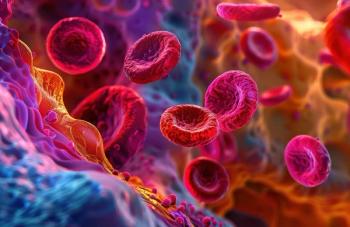
Researchers Push the Limits With PCSK9s, and Find Surprises
For some time, cardiologists have wondered whether there was anything to be gained by pushing LDL or "bad" cholesterol to very low levels.
How low should we go?
That’s the question cardiologists have asked for a while about low-density lipoprotein (LDL) cholesterol, which is the known culprit in atherosclerosis, the condition that causes plaque to accumulate in the arteries. It turns out that for many of these patients, there’s much to be gained by pushing LDL cholesterol to previously unimagined levels, according to trial results presented Tuesday at the 2016 American Heart Association Scientific Sessions in New Orleans.
Results, presented by Steven E. Nissen, MD, chief of cardiology of the Cleveland Clinic, were simultaneously published in JAMA.1
When a new class of cholesterol-fighting treatments—the PCSK9 inhibitors—came on the scene in 2015, FDA approved them for patients with atherosclerosis (along with statins) who had been unable to lower cholesterol with other therapy.
But the question remained: was there a point at which lowering LDL cholesterol stopped producing benefits, and thus this powerful, expensive therapy could be stopped?
It’s an important question, because the 2 approved versions—Amgen’s evolocumab (Repatha) and Sanofi-Regeneron’s alirocumab (Praluent) were both listed at wholesale prices above $14,000 a year, and health plans and pharmacy benefit managers have set up strict protocols on who can have the drugs.
When Amgen announced in September that Tuesday’s trial, called GLAGOV, had met its endpoints, executive vice president Sean E. Harper, MD, said in a
The study found that PCSK9 inhibitors could push LDL cholesterol well below 60 mg/dL, even to 20 mg/dL, and that the drugs produced regression benefits as well, Nissen said.
As Nissen explained in a press briefing, the trial involved 968 patients with established coronary disease who were all given statins and either evolocumab or a placebo. Researchers used intravascular ultrasound to examine a coronary artery at baseline. After 78 weeks, the ultrasound was repeated to see who benefited from treatment.
The evolocumab group achieved an average LDL cholesterol level of 36.6 mg/dL, compared with the statin-only group, which stayed around the same at 93 mg/dL. In the treatment group, 64% showed regression, vs 47% in the placebo group.
Nissen said researchers went into the study prepared for the possibility that they might not see any benefit of lowering LDL cholesterol beyond 60 mg/dL. “I thought there might be diminishing returns,” he said. “We don’t see that.”
While larger trials are needed, so far the safety results look good as well. Cardiovascular safety results for PCSK9 inhibitors are still pending.
What of the 35% who still progressed? Commenter Paul Santos, MD, of the University of Sao Paolo, said the results suggest that patients should be treated earlier or longer.
Earlier in the session, Kausik Ray, MD, MPhil, of Imperial College in London, UK, presented preliminary data on a new concept of PCSK9 treatment, which instead of blocking the enzyme with monoclonal antibody injections every 2 to 4 weeks would reduce the frequency of treatment to 2 to 4 times a year through a novel process called RNA interference.
Through this process, a synthethic particle blocks the gene that regulates PCSK9 in the liver, instead of going after the enzyme itself. As Ray explained, the process is being tested now and if successful will be moved into phase 3 trials.2
After the session, Ray told The American Journal of Managed Care it was far too early to say how this approach would affect costs relative to the current approach. However, he said it could have a positive effect on adherence, since patients would receive treatment during an appointment with a physician. Already, he said, it’s been observed that some patients are abandoning PCSK9 prescriptions at the pharmacy. Studies have shown drug abandonment can occur due to cost.
Additional Results From ODYSSEY. Monday’s presentations featured additional analyses of polled data from the phase 3 ODYSSEY CHOICE I trial, which compared alirocumab’s effectiveness with exetimibe in lowering LDL cholesterol. Results showed alirocumab was more effective than ezetimibe in helping patients with LDL cholesterol levels above 130 mg/dl reach levels below 70 mg/dL. The difference in the effectiveness of alirocumab and ezetimibe became especially apparent among patients with a baseline LDL cholesterol above 100 mg/dL, and authors reported that no patients with very high levels at baseline—those above 190 mg/dL—reached recommended levels on ezetimibe. Study authors said these findings should guide treatment decisions as well as guideline recommendations.3
Treatment for Familial Hypercholesterolemia. Patients with the rare genetic condition heterozygous familial hypercholesterolemia (HeFH) can be treated with doses of 75 mg or 150 mg of alirocumab, but authors sought information on how to make dosing decisions in a practice setting. This study involved 909 patients, mean age 54.6 years, 56.1% male, who started on 75 mg dose plus a background statin. Physicians could move patients up to 150 dose if needed in clinical judgment. Median time to first dose incrase was 12.6 weeks, in nearly all cases due to LDL cholesterol being too high. Mean level of those on 75 mg dose (every 2 weeks) who maintained dose was 67.6 mg/dL. Mean level for those who increased dose was 128.7 mg/dL.4
References
1 Nissen SE. Puri R, Anderson T, et al. Effect of evolocumab on progression of coronary disease in statin-treated patients: the GLAGOV randomized clinical trial [published online November 15, 2016]. JAMA. doi:10.1001/jama.2016.16951
2. Ray KK. Inhibition of PCSK9 synthesis via RNA interference. Presented at the 2016 American Heart Association Scientific Sessions. November 15, 2016.
3. Cannon CP, Cariou B, Valcheva V. Comparison of low-density lipoprotein cholesterol threshold attainment with alirocumab versus ezetimibe treatment in the ODYSSEY program. Presented at the 2016 American Heart Association Scientific Sessions. November 14, 2016. Poster M2014. -
4. Hoving GK, Guyton JR, Dufour R. Alirocumab dosing in a real world setting: data from an open-label treatment extension to the ODYSSEY program for patients with Heterozygous Familial Hypercholesterolemia. Presented at the 2016 American Heart Association Scientific Sessions. November 14, 2016. Poster M2052.
Newsletter
Stay ahead of policy, cost, and value—subscribe to AJMC for expert insights at the intersection of clinical care and health economics.












































